Packing for a move is rarely anyone’s idea of fun. And if you’re not choosing our professional packing services, it’s the kind of task that starts with enthusiasm and ends with you questioning why you own such odd things. But knowing what to pack first when moving can make all the difference, changing a chaotic process into a more manageable transition.
Whether you’re moving your home or relocationg your business, a little planning goes a long way! By packing room by room and starting with items you don’t use every day, you can stay organized and protect your belongings without going crazy. Here’s how we would pack your home and some advice if you decide to pack yourself!
Before You Pack
Before you jump straight into packing, make sure you prep some things beforehand. Being prepared saves you time, so you don’t have to worry about it later on. Here’s what you’ll need:
- Boxes in various sizes: Small for heavy items like books or kitchenware, large for lightweight, bulky items like linens or pillows.
- Packing supplies, including bubble wrap, packing paper, stretch wrap, and strong packing tape.
- Labels and markers: Clearly mark each box with the room and contents. Consider a simple color-coding system for quick identification.
- Checklists for each room to track what’s packed and what’s left.
- A dedicated “first day/night” box with essentials like toiletries, phone chargers, medications, snacks, and important documents.
And don’t forget: declutter before you pack. If you haven’t used it in months or can’t remember what it is, it might be time to donate, sell, or recycle it. Less stuff means less to pack, move, and unpack!

What to Pack First When Moving: A Room-by-Room Guide
The key to great packing is working from the least-used spaces and items to the most essential. Here’s how to do it, room by room.
Living Room
Pack first: Books, seasonal décor, board games, and decorative items you don’t use daily. Wrap fragile pieces like vases, picture frames, and lamps with care.
Pack later: Electronics, remote controls, frequently used blankets, and throw pillows.
Tip: Take photos of your TV and sound system setup before disconnecting anything. Label cords with tape or tags to make reassembly at your new place a breeze.
Kitchen
Pack first: Dishes that you don’t really use, specialty cookware, holiday items, and extra pantry goods.
Pack later: Everyday plates, mugs, cutlery, and appliances like the coffee maker or toaster.
Tip: Label boxes “Fragile – Kitchen” and wrap glasses and ceramics individually. Cover knife blades with cardboard or tape so there aren’t any accidents when unpacking.

Bedroom
Pack first: Off-season clothing, extra bedding, decorative pillows, and items stored in rarely-used drawers.
Pack later: Daily outfits, pajamas, nightstand essentials (glasses, medications), and personal care products.
Bathroom
Pack first: Extra towels, backup toiletries, and cleaning supplies.
Pack later: Toothbrush, toothpaste, soap, medications, and other daily-use items.
Tip: Pack essentials in a separate, easily accessible bag so you can find them quickly on moving day.
Home Office
Pack first: Old files, reference books, unused office supplies, and decorative items.
Pack later: Active work projects, laptops, chargers, and stationery you use every day.
Tip: Back up your computer and label each cord. A quick photo of your desk setup can save hours of tinkering later.
Garage & Storage Areas
Pack first: Tools, seasonal equipment (like lawn mowers or snow gear), sports equipment, and holiday decorations.
Pack later: Items you still use regularly, like gardening tools or workout gear.
Tip: Group similar items together and label boxes clearly like “Garage – Tools” or “Storage – Holiday Decor” to speed up unpacking.

Laundry Room
Pack first: Extra detergents, cleaning supplies, laundry baskets not in daily use, and ironing accessories.
Pack later: The detergent you’re currently using, your iron, and dryer sheets.
Tip: Keep your washer and dryer accessible until the last few days to avoid mountains of laundry later.
Hallways
Pack first: Wall art, console tables, and seasonal rugs.
Pack later: Rugs or mats you use daily, coat hooks with jackets you’ll need until the move.
The great thing about clearing hallways early is that it creates more space to move boxes and reduces tripping hazards!
Entrances & Mudroom
Pack first: Shoes you don’t wear daily, seasonal coats, umbrellas, and rarely used storage items.
Pack later: Everyday shoes, jackets, keys, and bags that you use daily.
What to Pack First When Moving a Business: A Step-by-Step Approach
The same principles apply when moving an office or business. Start with what’s least important and save what’s necessary for day-to-day operations.
Step 1: Electronics
Pack first: Spare devices, outdated equipment, and archived files.
Pack later: Computers, phones, and any hardware needed for daily work.
Tip: Photograph setups and label cords for quick reassembly.
Step 2: Office Supplies
Pack first: Extra stationery, old folders, and unused supplies.
Pack later: Pens, notebooks, and daily-use items. Keep a small kit handy for the final days.

Step 3: Furniture & Decor
Pack first: Decorative items, extra chairs, and non-essential shelving.
Pack later: Desks, primary seating, and employee workstations. Disassemble large pieces for easier transport.
Step 4: Files & Documents
Pack first: Archived records, old invoices, and reference materials.
Pack later: Active files and ongoing project documents. Use labeled or color-coded boxes for fast retrieval.
Other Tips For Packing
- Label everything clearly. Include the room, contents, and notes like “Fragile” or “Open First.”
- Use the right box for the job. Small boxes for heavy items, large ones for light and bulky goods.
- Wrap fragile items properly. Bubble wrap, packing paper, or even soft clothing can provide cushioning.
- Take your time. Rushing leads to mistakes. Focus on progress, not perfection.

Pack Smart, Not Hard
Understanding what to pack first when moving is one of the most effective ways to reduce stress and stay in control. A room-by-room strategy helps you pack efficiently, protect your belongings, and make unpacking far less overwhelming.
Start with items you don’t use every day and save essentials for last; you’ll turn what could be a stressful ordeal into a manageable process! Start early and remember that what to pack first when moving isn’t just about boxes and tape, it’s about giving yourself some peace of mind for a stressful task. And that’s worth every carefully wrapped dish!
If you went through this whole blog and still feel like you don’t want to pack, our moving company in Ontario has add-on packing services so you can move stress-free!
